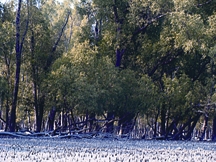Keora
Keora name for one of the tallest trees in the Sundarbans mangrove forests, Sonneratia apetala. It can attain a height of about 20m and a girth of about 2.5m. The tree occurs on newly accreted soil in moderately to strongly saline areas and is considered as a pioneer species in ecological succession. The species is distributed in India, Bangladesh, and Myanmar. The leaves are simple opposite, entire and leathery. The flowers are bisexual.

The fruit is almost round and about 2-3 mm wide. A fruit contains 25-125 seeds. In Bangladesh its timber is used for paneling, packing boxes, furniture, and fuelwood. The felling cycle of keora is 20 years and the tree must have a minimum diameter of about 30 cm at breast height to be cut. A physical rotation of 12-15 years has been found suitable for mangrove plantations.
Sonnerati apetala is the principal planting species in the massive mangrove plantations of Bangladesh. In fact, it alone constitutes about 95% of the plantations on new accretions in coastal areas. Ripe fruits of keora are collected in August and seeds are obtained following pretreatment of fruits. The seedlings are raised in nursery beds. Planting of seedlings is undertaken during the monsoon which has been found to be the physiologically optimal time of planting. Presently, a planting spacing of 1.5m x 1.5m is followed.
The growth of S. apetala is quite fast compared to other mangrove species. It is a strong light demanding species. The trees produce upright, rather sharp pneumatophores from superior roots. In dense stands it develops a single straight bole, growing to a greater height than any other species in the area. However, the stand deteriorates very quickly after maturity. [Neaz Ahmad Siddiqui]
Keora beehole borer a stem boring moth larva, Zeuzera conferta (Cossidae) that constitutes the most important pest of the mangrove tree keora, (Sonneratia apetala) growing in the Sundarbans. Keora is widely utilized as a plantation species to create a shelter belt along the coastal areas and offshore islands of Bangladesh. Infestation by the keora beehole borer was first detected at Char Kashem in 1983.
The larva bores into the bark and later makes large, oval and ramifying tunnels in the wood. At the initial stage the bark is stained with sap coming out from the larval entrance hole. Globular excretory pellets and wood frass are ejected outside, that accumulate at the base of the tree. The trunk of a tree may harbour hundreds of active larvae inside. Though the attacked trees are not killed outright by the borer, their numerous tunnels make the tree susceptible to wind damage. The larval holes and tunnels also serve as passages for invasion by wood decaying fungi. Besides keora, the pest also attacks other mangroves such as Sonneratia caseolaris, Avicennia officinalis, A. alba and Tamarix indica. Woodpeckers and predatory ants are known to feed on the pest.
A survey covering all the planted mangrove areas revealed a mean infestation of about 52%, whereas in the Sundarbans the mean infestation is about 22%. The more recent and practical recommendations for the management of the pest are selective felling of heavily infested trees during winter in order to destroy the broods; raising keora with compatible mangrove species to establish a mixed stand, using relatively superior seeds from borer free trees selected from amongst the infested trees, and removing alternative host plants of the borers. [Md Wahed Baksha]
See also sundarbans.
